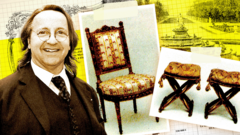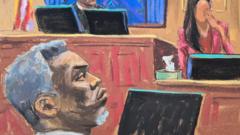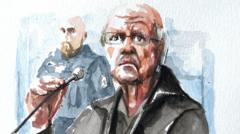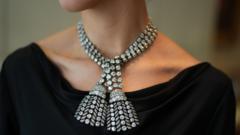This article delves into the intricate fraud involving fake royal furniture that deceived prominent collectors and institutions, including the Palace of Versailles.
The Versailles Furniture Fraud: A Scandal Unveiled

The Versailles Furniture Fraud: A Scandal Unveiled
A tale of deception in the realm of high-value antiques and its repercussions on cultural institutions.
In the early 2010s, the French antiques market was ignited by the emergence of two opulent chairs purported to have graced the Palace of Versailles. These chairs, believed to be invaluable artifacts crafted for Marie Antoinette, bore the seal of Nicholas-Quinibert Foliot, a renowned cabinetmaker in 18th century Paris. Declared "national treasures" by the French government in 2013 at Versailles' behest, these chairs piqued interest but ultimately sold to Qatari Prince Mohammed bin Hamad Al Thani for a staggering €2 million (£1.67 million) after Versailles deemed the price excessive.
This instance is part of a larger trend where numerous royal 18th-century furniture pieces emerged in the antiquities market. Many of these items were acquired for display in Versailles' expansive museum collection, while others found homes within the wealthy elite, including the Guerrand-Hermès family.
However, in 2016, these lavish chairs were ensnared in a national scandal that tainted the French antiques sector. An extensive investigation revealed that the chairs were nothing more than elaborate fakes. This led to a high-profile trial involving prominent antiques expert Georges “Bill” Pallot and noted cabinetmaker Bruno Desnoues, who faced charges of fraud and money laundering spanning a nine-year period. Galerie Kraemer and its director, Laurent Kraemer, also contended with serious accusations of gross negligence in selling the fabricated chairs.
The seeds of this deception were sown in 2007, as Pallot humorously collaborated with Desnoues to replicate a chair they were restoring. Their initial success forged a pathway to fraudulent imitation, leading to the creation of more forged pieces. Pallot managed to procure low-cost wood frames, while Desnoues skillfully aged wood and applied authentic-looking finishes. The duo eventually sold these fakes through middlemen to prestigious galleries, enmeshing institutions like Versailles in a web of deceit.
While Pallot characterized himself as the "head" of the operation with Desnoues as the "hands," the pair accrued substantial profits—allegedly over €3 million, although they claimed closer to €700,000. The money was funneled through foreign bank accounts, raising flags for authorities who soon traced the chicanery back to Pallot and Desnoues through the extravagant lifestyles of their accomplices.
The trial accentuated the necessity for better regulatory frameworks within the art and antiques market, an assertion emphasized by prosecutor Pascal Rayer. An investigation into suspicious property acquisitions led to an inspection of various individuals involved, exposing the operation's scale and scope.
Initially charged were several parties, including middlemen, but many charges diminished over time. However, the allegations against Laurent Kraemer and his gallery persisted. Prosecutors contended that the gallery exhibited a degree of negligence by failing to authenticate the items meticulously before sale. Defending their position, Kraemer's lawyers argued that the gallery was simply a victim of the fraud and lacked knowledge of the furniture's fake nature.
As the court proceedings continue, the broader implications of this case on the art market remain a critical point of discussion, particularly regarding authenticity verification and the reputational risks faced by institutions and dealers alike.
This instance is part of a larger trend where numerous royal 18th-century furniture pieces emerged in the antiquities market. Many of these items were acquired for display in Versailles' expansive museum collection, while others found homes within the wealthy elite, including the Guerrand-Hermès family.
However, in 2016, these lavish chairs were ensnared in a national scandal that tainted the French antiques sector. An extensive investigation revealed that the chairs were nothing more than elaborate fakes. This led to a high-profile trial involving prominent antiques expert Georges “Bill” Pallot and noted cabinetmaker Bruno Desnoues, who faced charges of fraud and money laundering spanning a nine-year period. Galerie Kraemer and its director, Laurent Kraemer, also contended with serious accusations of gross negligence in selling the fabricated chairs.
The seeds of this deception were sown in 2007, as Pallot humorously collaborated with Desnoues to replicate a chair they were restoring. Their initial success forged a pathway to fraudulent imitation, leading to the creation of more forged pieces. Pallot managed to procure low-cost wood frames, while Desnoues skillfully aged wood and applied authentic-looking finishes. The duo eventually sold these fakes through middlemen to prestigious galleries, enmeshing institutions like Versailles in a web of deceit.
While Pallot characterized himself as the "head" of the operation with Desnoues as the "hands," the pair accrued substantial profits—allegedly over €3 million, although they claimed closer to €700,000. The money was funneled through foreign bank accounts, raising flags for authorities who soon traced the chicanery back to Pallot and Desnoues through the extravagant lifestyles of their accomplices.
The trial accentuated the necessity for better regulatory frameworks within the art and antiques market, an assertion emphasized by prosecutor Pascal Rayer. An investigation into suspicious property acquisitions led to an inspection of various individuals involved, exposing the operation's scale and scope.
Initially charged were several parties, including middlemen, but many charges diminished over time. However, the allegations against Laurent Kraemer and his gallery persisted. Prosecutors contended that the gallery exhibited a degree of negligence by failing to authenticate the items meticulously before sale. Defending their position, Kraemer's lawyers argued that the gallery was simply a victim of the fraud and lacked knowledge of the furniture's fake nature.
As the court proceedings continue, the broader implications of this case on the art market remain a critical point of discussion, particularly regarding authenticity verification and the reputational risks faced by institutions and dealers alike.


















